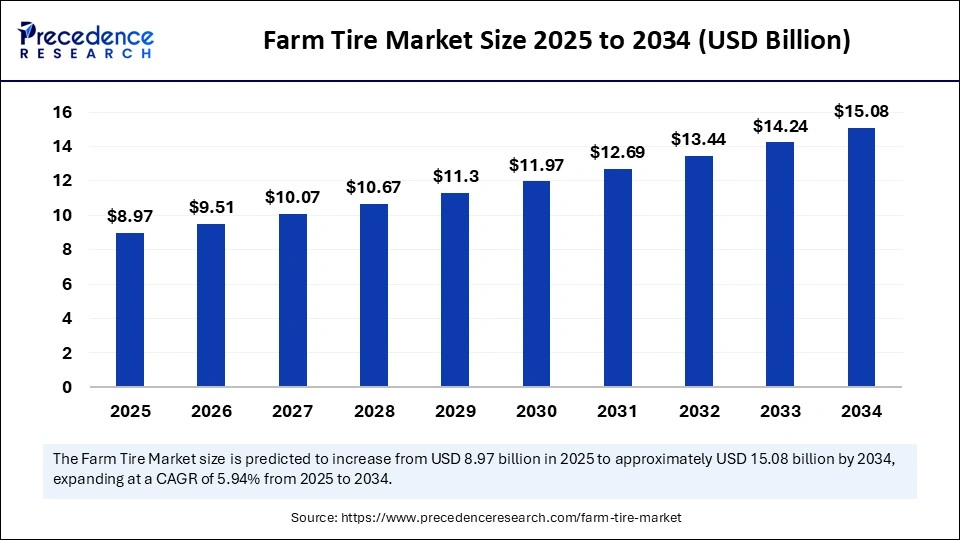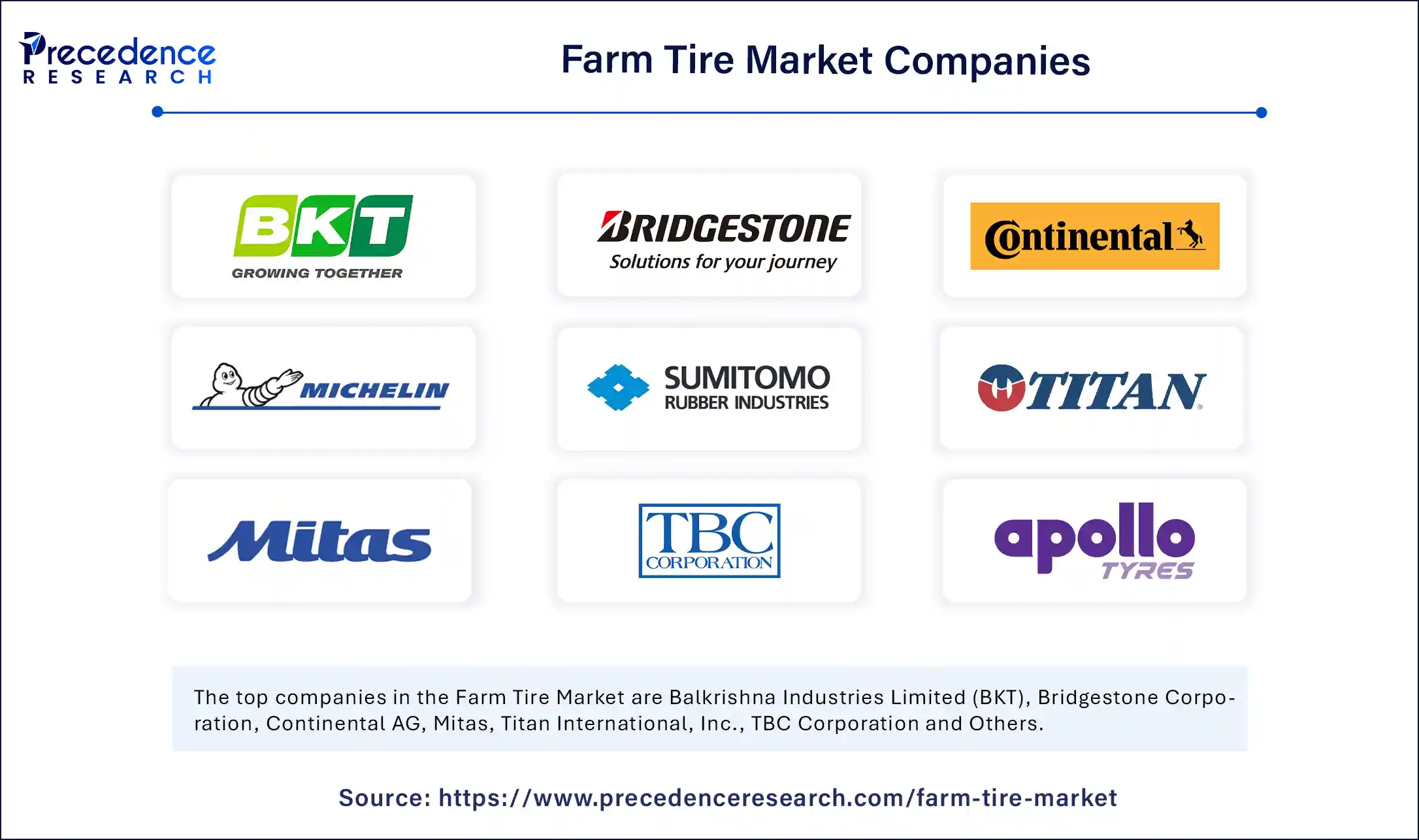
Farm Tire MarketKey Takeaways
- In terms of revenue, the farm tire market is valued at $8.97 billion in 2025.
- It is projected to reach $15.08 billion by 2034.
- The market is expected to grow at a CAGR of 5.94% from 2025 to 2034.
- Asia Pacific dominated the global market with the largest market share of 44% in 2024.
- Europe is expected to witness the fastest CAGR of 5.2% during the forecast period.
- By product, the bias tires segment held the largest revenue share of 58% in 2024.
- By product, the radial tires segment is expected to grow at a significant CAGR of 5.6% during the forecast period.
- By distribution channel, the aftermarket segment captured the biggest market share of 62% in 2024.
- By distribution channel, the OEM segment is anticipated to grow at a rapid pace in the market over the forecast period.
- By application, the tractors segment held the largest revenue share of 45% in 2024.
- By application, the harvesters segment is expected to expand at a significant CAGR in the upcoming period.
How is Artificial Intelligence Revolutionizing the Farm Tire Market?
The farm tire market is undergoing revolution, improving performance, efficiency, and precision. This is achieved through the integration of AI technology, which uses sensors embedded in tires to continuously monitor pressure, temperature, and wear. Farmers receive notifications about equipment failures and recommendations to optimize field performance. This data enables predictive maintenance and reduces downtime.
Market Overview
The Farm Tire Market is experiencing robust growth as global agriculture increasingly shifts toward mechanization and modern equipment. As farmers adopt advanced machinery such as tractors, harvesters, sprayers, and trailers, the demand for durable, efficient, and high-performance farm tires continues to rise. The farm tire segment includes various tire types designed specifically for agricultural use, built to withstand heavy loads, challenging terrains, and long operational hours. From small family-owned farms to large-scale commercial operations, the need for high-traction and fuel-efficient tires has significantly contributed to the evolution of the Farm Tire Market. Farm tires play a crucial role in ensuring field productivity, equipment stability, and overall cost efficiency in modern farming practices. With rising global food demand and expanding cultivation areas, the market is projected to witness consistent growth over the forecast period.
Drivers
The primary drivers of the Farm Tire Market include rapid mechanization of agriculture in both developed and developing economies, growing awareness about farm productivity, and increasing government support through subsidies for farm equipment. A surge in demand for tractors and other mechanized farm vehicles has directly contributed to tire sales. Improvements in radial and bias tire technologies have led to better fuel economy, reduced soil compaction, and enhanced grip in wet and uneven field conditions. The rising cost of manual labor has further accelerated the shift toward automated farming systems, which in turn drives the need for specialized tires. Additionally, tire manufacturers are focusing on advanced tread patterns and materials that increase tire lifespan, reduce slippage, and support sustainable farming efforts. These technological improvements are playing a pivotal role in the expansion of the Farm Tire Market.
Opportunities
The Farm Tire Market presents considerable opportunities across emerging economies where agricultural modernization is gaining momentum. In regions such as Southeast Asia, Africa, and Latin America, a growing middle class, increased access to financing, and government-backed rural development programs are helping farmers invest in tractors and equipment. This presents a large untapped market for both OEMs and aftermarket suppliers. Another major opportunity lies in the development of smart tires integrated with sensors and telematics systems that monitor pressure, load, and wear in real-time. These intelligent solutions enable predictive maintenance, thereby minimizing downtime and improving efficiency. Furthermore, the rising demand for eco-friendly tires made from sustainable materials or those that reduce soil degradation opens a new segment for environmentally conscious consumers and regulatory-driven markets.
Challenges
Despite the promising outlook, the Farm Tire Market faces challenges related to fluctuating raw material prices, supply chain disruptions, and limited availability of skilled labor for tire installation and maintenance in remote areas. The high initial investment for premium tires can be a barrier for small and marginal farmers, particularly in developing countries. In addition, climate-related risks such as prolonged droughts, floods, and changing growing seasons can affect farm income and reduce investments in equipment, including tires. Also, competition from local low-cost tire manufacturers in price-sensitive regions can limit the market penetration of established global players. The need for frequent tire replacements due to rugged terrain and extreme weather can also be burdensome for cost-conscious farmers, which may affect overall demand in certain markets.
Regional Insights
Geographically, Asia Pacific leads the global Farm Tire Market with the largest share due to the extensive agricultural activities in countries such as India, China, and Indonesia. Government subsidies, rising farm mechanization rates, and increasing rural incomes contribute significantly to regional market growth. Europe is witnessing strong demand for technologically advanced and environmentally friendly farm tires, driven by strict regulations on soil compaction and emissions. North America remains a mature yet lucrative market, where large-scale farms and agri-businesses continue to invest in high-end machinery equipped with premium tires. Meanwhile, Latin America and the Middle East are gradually emerging as growth hubs owing to increasing food production needs and infrastructural investments in agriculture.
Recent Developments
Recent trends in the Farm Tire Market include the launch of next-generation radial tires with enhanced sidewall flexibility and improved soil protection capabilities. Leading manufacturers are introducing new product lines tailored to specific crop types and machinery, such as flotation tires for harvesters and narrow tires for row crop tractors. Companies are also expanding their aftermarket distribution networks to cater to replacement demand. Strategic partnerships between tire makers and agricultural equipment manufacturers are enabling seamless integration and optimized performance. Additionally, digital platforms for tire inventory tracking and online purchase have become more prevalent, especially post-pandemic, allowing greater accessibility for remote buyers. Ongoing R&D efforts continue to focus on sustainability, durability, and smart tire innovations to meet the evolving demands of modern agriculture.
Farm Tire Market Companies

- Balkrishna Industries Limited (BKT)
- Bridgestone Corporation
- Continental AG
- Compagnie Générale des Établissements Michelin (CGEM)
- Sumitomo Rubber Industries, Ltd.
- Titan International, Inc.
- Mitas
- TBC Corporation
- Apollo Tyres Ltd.
- Hankook Tire
- MRF Limited
- JK Tyre & Industries Ltd.
- CEAT
- The Carlstar Group, LLC
- Specialty Tires of America, Inc.
- Alliance Tire Group (ATG)
- Trelleborg AB
Segments Covered in the Report
By Product
- Bias
- Radial
By Application
- Tractors
- Harvesters
- Forestry
- Irrigation
- Implements
- Sprayers
By Distribution Channel
- OEM
- Aftermarket
By Region
- North America
- Asia Pacific
- Europe
- Latin America
- Middle East & Africa
Get Sample@ https://www.precedenceresearch.com/sample/6219